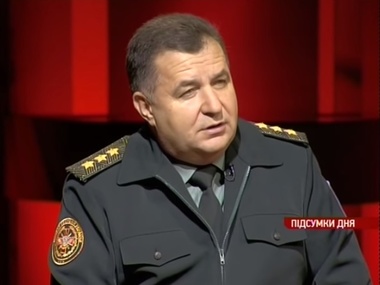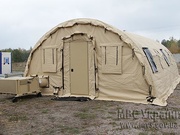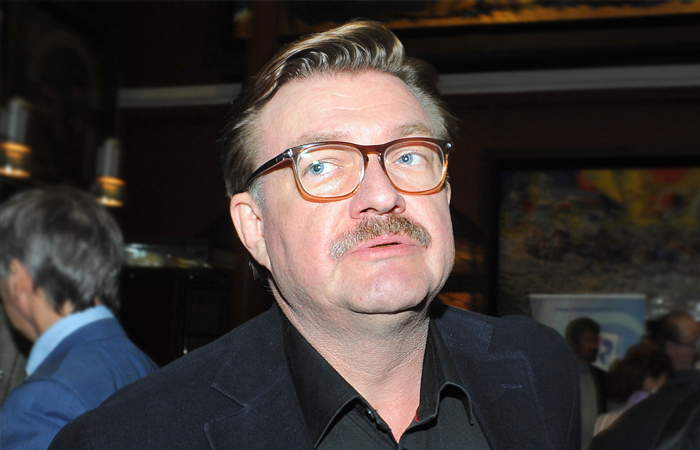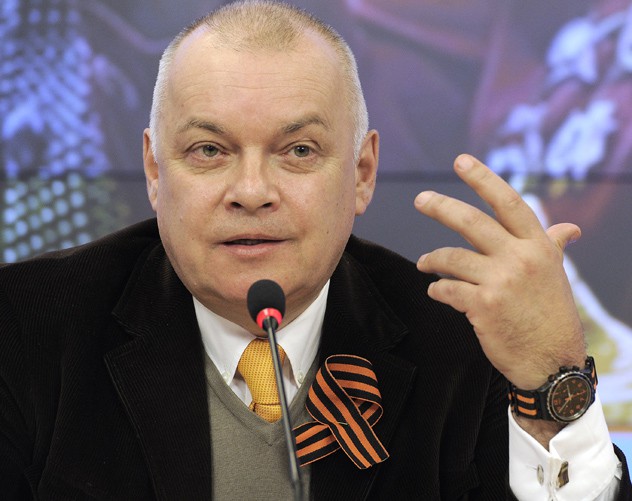Yesterday’s liveblog can be found here. An archive of our liveblogs can be found here. For an overview and analysis of this developing story see our latest podcast.
Please help The Interpreter to continue providing this valuable information service by making a donation towards our costs.
View Ukraine: April, 2014 in a larger map
For links to individual updates click on the timestamps.
For the latest summary of evidence surrounding the shooting down of flight MH17 see our separate article: Evidence Review: Who Shot Down MH17?
Below we will be making regular updates so check back often.
The self-proclaimed Lugansk People’s Republic is moving to Moscow time, ITAR-TASS reported.
Previously Lugansk was on Kiev time, which is one hour earlier than Moscow.
The change will take place overnight this weekend at 3:00 am on October 26.
Earlier, the self-proclaimed “Donetsk People’s Republic” announced it was planning to switch to Moscow time shortly.
Boris Litvinov, the DPR’s speaker of parliament, said the reason for the change was the fact that Moscow and
Donetsk are really located in the same time zone geographically.
With cold weather coming soon, Ukraine is concerned about how it will keep its soldiers warm this winter, the Ukrainian news site gordonua.com reports.
After President Petro Poroshenko ordered him on October 15 to cut through the red tape involved in procurement, the new defense minister Stepan Poltorak complained about problems in suppling the army with winter uniforms,
Ukrainian blogger Yury Kasyanov said that the Defense Ministry “deserves a 2 out of 5 points” for the way it has supplied the army, and that volunteers are trying to make up the shortfall.
The problem is that with active combat over in many areas except in Donetsk and environs, donations have to supply the army have fallen. Yet without such help, the army would have done much worse this year. The Defense Ministry is being blamed for incompetency, say soldiers and volunteers.
Poltorak made a statement about winter supplies yesterday October 22 (translation by The Interpreter):
When we learn to speak the truth to each other, then we won’t have problems. Unfortunately, there are problems with supplies in the Armed Forces of Ukraine. We need to manage to clothe people. That’s related to the fact that administrative decisions were taken belatedly, and the system which was created in the Armed Forces and the Defense Ministry did not enable us to make decisions quickly.

Poroshenko had wanted the army suited for winter by October 10. But according to volunteers who saw the uniform purchased by the Defense Ministry, the sets include shoddy boots and thin underwear.
You can say that the boots are devilishly inconvenient and coarse and judging from everything, they will last a week in the rains in the fields. The thermal underwear can only be said to be ‘thermal’ conditionally, but it works as a fake. There are no sweaters or fleeced items. At least, not discovered yet,” said Roman Donik, a volunteer.
The US has helped by supplying tents, gordonua.com reported
The tents were presented to the National Guard in a ceremony at the training center, the Cabinet of Ministers announced October 17.

The tents reportedly can be set up in 15 minutes and house from 15-30 soldiers. They are outfitted with air conditioning and light and supposedly can ensure winter camping as well. They have been tested by the US army from Alaska to Afghanistan.
Volunteers brought in heated containers to Ukrainian forces at checkpoints in Mariupol earlier this month, says gordonua.com.
Ukrainian weather forecasters are expecting heavy rains and wet snowfalls in the next days.
The burn-out hulls of two tanks and other items found near the town of Starobeshevo (Starobesheve) in Ukraine prove that Russian forces have been fighting in Ukraine, Reuters reported today.
Reuters showed photographs of the two badly damaged tanks, one of which had lost its turret, to four independent military experts, who said they were of a type used exclusively by the Russian army:
At least one, they agreed, was a T-72BM – a Russian-made modification of a well known Soviet tank. This version of the tank, they said, is not known to have been exported.
“It is operated by the Russian Army in large numbers, but crucially it is not known to have been exported or operated outside of Russia,” Joseph Dempsey, a military analyst for the London-based International Institute for Strategic Studies, wrote in late August when a tank like that was discovered on grainy footage of rebel convoy.
“The presence of this variant in Ukraine therefore strongly supports the contention that Russia is supplying arms to separatist forces,” Dempsey said.
The military experts were shown photographs of the two tanks and said the second was either the same as the first, a T-72BM, or a slightly different model, a T-72B1. Precise identification was difficult due to the extent of damage.
On August 18, The Interpreter reported the sighting of a T-72 tank in a Russian convoy, which we geolocated in the town of Sukhodolsk, heading in the direction of Lugansk.
In addition to the tanks, Reuters gathered some eye-witness testimonies that point to Russian involvement in the battle.
A Ukrainian soldier captured near Ilovaisk on August 24-25 said his unit was hit by Grads and quickly defeated. He said they were Russians from the Kostroma airborne assault battalion.
A woman in Horbatenko who lived near the battlefield, who was slightly wounded by shrapnel, said she saw an armored convoy with white circles and white flags with troops they didn’t know.
Russian troops commonly remove identifying numbers from armor and paint such circles on their vehicles when they move into Ukraine; Ukrainians do not use such circles but have white stripes instead.
Reuters said one of the BMP-2s had a white circle on its broken turret.
Reporters also found the parts of an anti-tank missile which was identified as a Korent ATGM, not exported to Ukraine by Russia. Russian MREs marked as produced for the Russian Defense Ministry were also found at the site, along with empty bottles of mineral water shown to have been made in Ivanovo.
Ukraine accused Russia of invading its territory when the Ukrainian army captured paratroops near Horbatenko who said they served in the 98th division in Ivanovo. President Vladimir Putin said they had gotten “lost” while patrolling the border.
Burko News also reported today a photo showing a T-90 tank, using research from Irakli Komaxidze of Informnapalm.org.
In another photo, the soldier points to a local highway sign that says “Starobeshevo.”

The soldier’s name visible on the photos is Vitalek Marakasov. That account is already showing as deleted on VKontakte, as often happens when such revealing photos are published.
But the VK page is still available in Google’s cache. In the cache version, however, the soldier has a profile photo of himself in civilian clothing, although there are some army photos on his page in past posts. The photo of the tank is not visible on this account, as the photos are not accessible in the cache. Therefore we could not confirm them.
Burko said the unit involved was the tank battalion of Russia’s 136th Motorized Rifle Brigade (m/u 63354) based in Buinaksk, Dagestan
Ukrainian border guards had a mix-up today October 23 trying to deport a Russian journalist they believed was there to prepare disinformation on their country.
Yevgeny Kiselyov, a prominent Russian reporter who has lived and worked in Kiev for years as a TV show host, was stopped at the border when he landed at Borispol Airport and kept in the room for deportees.

Yevgeny Kiselyov, talk show host on Ukrainian TV channel Inter.
Eventually it was determined that Yevgeny had been mistaken for the notorious TV host Dmitry Kiselyev with the same last name (the name can be transliterated differently depending on the stress on the last syllable).

Dmitry Kiselyev, TV host and state media company company director.
Dmitry Kiselyev is head of Rossiya Segodnya [Russia Today], the parent company for Russia Today, RIA Novosti and other state media outlets, and is a host for Rossiya-1’s Vesti nedelyi [News of the Week]. On that program, he declared earlier this year that Russia is capable of reducing the US “to nuclear ash,” and denounced gays, saying accident victims should have their hearts burned.
Yevgeny Kiselyov was formerly an anchor for NTV, back when it was an independent TV station in the Yeltsin era.
He later worked at Channel 6, Moscow News and Ekho Moskvy before moving to Kiev in 2008 to become TVi’s main consulting editor in 2008. He then began working at Inter in 2009, and now hosts a program called Chernoye Zerkalo (Black Mirror).
Meanwhile Dmitry Kiselyev has been involved in a number of controversies in his role as state TV presenter.
He blasted Sweden for failing to have moral values due to its support of the EuroMaidan protests. He has called Ukraine a “failed state” and a “virtual country.” And he criticized two Jewish writers in Russia, Viktor Shenderovich and Igor Irtenyev, when they compared the Sochi Winter Olympics to the 1936 Summer Olympics in Berlin.
In August, the Ukrainian government issued a blacklist of 49 Russian journalists banned from the country.
Kyiv Post has published an interesting article on Ukraine’s communist party and its far right political parties. Polls show that the communists are polling much lower than they have historically, and Ukraine’s far right parties have lost even more ground since the presidential elections:
A joint poll by Kyiv International Institute of Sociology and Democratic Initiatives Foundation published on Oct. 22 gives [the communists] 4.1 percent of votes. The 16 other most likely losing parties also include the ideological antagonists of the communists — nationalist Svoboda party and Right Sector, the poll indicated…
In the 2012 election, Svoboda, led by Oleh Tiahnybok, unexpectedly managed to get more than 10 percent of votes that allowed them to have 38 seats in parliament, including 13 lawmakers elected in single election districts. But the current poll gives Svoboda only 3.1 percent of votes.
And then there is Right Sector (Pravy Sektor), the ultra-nationalist group often discussed by the Russian government. In the presidential elections their leader, Dmytro Yarosh, only received 0.7% of the vote. In the latest poll, Right Sector is polling at less than 2%.
And as ridiculous as it sounds, Darth Vader is going to get nearly as many votes as Right Sector:
The Internet Party of Ukraine is another probable loser. Registered only in late September, this party’s top five candidates are named after Star Wars heroes, including Darth Vader as party leader. Wearing a costume of movie hero, Vader calls himself a “candidate with human face.”
Being perceived by most people as just a funny joke, this party is still expected to get some 0.5 percent of votes, the poll shows. A number of commercials this party has on billboards and TV show that this project also combines good financing with advanced technology.
The Interpreter has an exclusive translation of an article in The Insider which exposes the real identity of the politicians behind the Internet Party.
Read the story on Kyiv Post: Polls show Communists, Svoboda, Right Sector heading for defeat in Oct. 26 parliamentary election
“If in 2012 we have covered 80% of the payments, in 2014 we have hardly completed 50%,” Prime Minister of Ukraine Arseniy Yatsenyuk commented on Wednesday.
According to the Government, public subsidies would not be enough to compensate for the current difference in gas rates.
“We are to fund directly from the Budget the difference in the tariffs. Currently the payments are being made through the local budgets,” Yatsenyuk explained, adding that Donetsk and Luhansk are the regions with the largest debt to Naftogaz, UAH 4 billion and UAH 1.2 billion respectively [US $400.4 million].
As we reported after recent talks in Milan, Russian President Vladimir Putin told Ukraine that no further deliveries would be made on credit, and that Ukraine itself must impose “a certain consumer discipline” due to “very low” levels of collection.
Yet the main collection problem stems not so much from individual consumers but from war-torn industrial companies in the Donbass dependent on gas for production.
A payment of $1.4 billion must be made by the end of October on Ukraine’s outstanding debt of $4.5 billion to Russia’s Gazprom for deliveries, RT.com reported.
Navtogaz has urged Slovakia’s Eustream to increase capacity of the Vojany-Uzhhorod pipeline. The pipeline was launched in early September 2014 to directly supply Ukraine from the EU.
Naftogaz has further challenged the contract signed by Eustream and Gazprom as violating the EU’s Third Energy Package and has urged that the contract be amended to enable two-way gas flows, says Natural Gas Europe.
The Special Monitoring Mission (SMM) of the Organization for Security and Cooperation in Europe (OSCE) has completed its first launch of unarmed and unmanned aerial vehicles:
The OSCE Special Monitoring Mission to Ukraine (SMM) today successfully
completed the maiden flight of its unarmed/unmanned aerial vehicles
(UAVs) before members of the media near Mariupol in eastern Ukraine.The roll-out of the UAV operations in eastern Ukraine will continue
Friday with, weather permitting, routine operational flights.
The UAVs, the Schiebel CAMCOPTER® S-100, are being provided, flown and
maintained by an Austrian company Schiebel under contract to the OSCE
and operated under the authority and direction of the SMM, with the
Mission’s monitors in close attendance. The data collected is the
property of the OSCE and for the Organization’s use only.
The Mission’s use of its UAVs aims at supporting the fulfilment of
its mandate through complementary aerial information-gathering focused
on monitoring the general security situation in Ukraine.
The UAVs will also be used for other tasks that are in line with the
SMM’s mandate; such as monitoring and reporting on the implementation of
the Minsk Protocol of 5 September and the Minsk Memorandum of 19
September 2014.
“The UAVs will enhance existing monitoring capabilities in fulfilment
of our mandate in Ukraine,” said Chief Monitor Ambassador Ertugrul
Apakan. “They will compliment what our monitors observe on the ground,
which will still be our primary source of information gathering.”
Initially, and until further notice, the SMM’s UAV will operate over
the area south of Donetsk down to the Sea of Azov, eastwards as far as
the Ukrainian-Russian state border and westwards towards the line of
contact.
Back in August, Ukrainian President Petro Poroshenko ordered a snap parliamentary election, and now the time has come: Ukrainians will go to the polls in three days, on October 26.
Yahoo provides a fact sheet on the parties:
Opinion polls suggest the new assembly will be dominated by pro-Europe parties, including Poroshenko’s bloc.
Yanukovich’s Regions Party has been erased as a political force and is not running. Its allies, the Communists, might not win any representation for the first time since independence in 1991.
The main parties competing are:
– The Poroshenko bloc comprising the Solidarity party of the president and Udar led by Vitaly Klitschko.
– Batkivshchyna (Fatherland) led by former prime minister Yulia Tymoshenko.
– Radical Party headed by Oleh Lyashko.
– People’s Front led by Prime Minister Arseny Yatseniuk.
– Strong Ukraine of former first deputy prime minister Serhiy Tigipko
– Communist party of Petro Simonenko
Kent Harstedt, an OSCE parliamentarian and observer of the upcoming ballot in Ukraine summarized the challenges in an article published by Radio Liberty/Radio Free Europe:
Imagine trying to hold an election at the most critical juncture in your country’s modern history — a vote that is vital for your nation’s security and place in the world. Imagine trying to hold the election amid threats from within and without, a teetering economy, an atmosphere of tense uncertainty, and under the watchful eye of the world. Now imagine trying to do it cleanly. Twice. Imagine Ukraine.
Harstedt notes that because people in southeastern Ukraine will not be able to participate in the elections, their seats will be left vacant. But Russian-backed separatist leaders are boycotting elections and won’t do anything to facilitate them.
Of course, hundreds of thousands of people have been forced to flee the region, either as internally-displaced persons within Ukraine or as refugees to Russia, and it is uncertain if they will have access to the ballot. And in Russian-occupied Crimea, of course it will be impossible to vote in Ukraine’s elections.
The Central Elections Commission reports that 49,915 Ukrainians have
registered within the Russian Federation to take part in the elections,
685 less than in the presidential elections in March, Unian and Deutsche Welle report. At least 200,000 Ukrainian citizens have requested asylum in Russia.
Unian also reported that of those internally displaced within Ukraine, estimated at more than 400,000, only 160,000 have submitted changes of address in order to vote, according to the Ministry of Labor and Social Policy.
The parliament has 450 seats; of these 424 deputies will likely be elected, leaving 26 seats due to the war and the separatists’ opposition to elections.
RFE/RL also has an article by Tom Balmforth on some of the people running in the elections including Mustafa Nayem, the Ukrainian journalist of Afghan origin whose Facebook post is credited with starting the EuroMaidan protests and Tetyana Chornovol, a journalist who was a member of the official body investigating corruption until her resignation earlier this year, when she cited obstacles to its work.
Chornovol’s husband, Mykola Berezovoy, a volunteer in the Azov Battalion, was killed in battle in Ilovaisk, and she fought in the war herself for a time.
As Balmforth says, this is a time when such activists may have a chance:
With Yanukovych’s formerly ruling Party of Regions in disarray and not contesting the elections, and with old stalwarts like Yulia Tymoshenko’s Fatherland party polling poorly, the door appears open for fresh faces.
Jamestown Foundation’s Eurasia Daily Monitor wrote yesterday October 22:
With several days remaining until the polls open in Ukraine on October 26, it is clear that President Petro Poroshenko’s party will win the early parliamentary election hands down. Opinion polls show that the Bloc of Poroshenko (BoP) is heading for a victory no less convincing than Poroshenko’s outright first-round victory in the early presidential election on May 25. The BoP will most probably form the basis of a pro-Western majority coalition.
This may be the end of bipolar politics in Ukraine and the start of something new. In the 1990s, communists opposed pro-market forces, and pro-Western forces ran neck and neck in elections with the largely pro-Russian Party of Regions (PRU) and its leader Viktor Yanukovych in 2004–2012. But Poroshenko’s party, founded only several months ago for the election, has no real rivals at the moment. The PRU, which dominated parliament in 2010–2013, was abandoned by Yanukovych (who fled the country for exile in Russia) earlier this year. And this former ruling faction has decided not to officially run any candidates in the October 26 election. The electoral base of the government’s would-be opponents has been destroyed by the February Maidan revolution, the annexation of Crimea by Russia in March, and the subsequent occupation of densely populated areas in the industrial Russian-speaking provinces of Donetsk and Luhansk (collectively known as the Donbas) by Russia-backed militant
Der Spiegel reporters have travelled around to Ukrainian cities to assess the mood before the elections. They found that in Lviv, often portrayed “as a stronghold for right-wing extremists” that in fact the ratings of Svoboda, an ultranationalist party which garnered 38 percent of the vote in 2012 parliamentary elections, has now seen its ratings “dropped dramatically.”
From an interview with Natalka Sniadanko, a writer and translator:
“We no longer believe in the patriotic rhetoric of the Svoboda party,” says Sniadanko, who notes that the party has been discredited here following reports that Svoboda members pressured the media and abused their political power to line their own pockets. It has also emerged that one of the party’s major donors was a Lviv millionaire with close connections to organized crime.
“The image that Svoboda people have of what it means to be Ukrainian is anti-modernist, and there is no longer a future for their ideal of Ukrainian villagers who are disdainful of mainstream culture,” says Sniadanko.
In Odessa, site of a tragic clash in May in which 38 people burned to death, Der Spiegel interviewed a businessman:
A frighteningly large number of people died on May 2,” says a businessman who asks that his name not be divulged. “But who knows: If that hadn’t happened, we might now have a second Donetsk here, and thus another protectorate of Moscow.” The disaster in the trade union building has made people in Odessa unwilling to talk openly about politics — creating an eerie silence. Russian TV channels have been switched off and broadcasts from Moscow can now only be received via satellite dish.
Der Spiegel reported that with police withdrawn in Odessa, Right Sector had taken justice into their own hands and beat a Verkhovna Rada MP and also “seized drug dealers, painted them with red paint and tied them to street poles as a deterrent.” It is not clear whether Right Sector is being deployed by oligarchs to settle scores, says Der Spiegel.
Estonia’s Postimees reports that a Russian Il-20 electronic intelligence gathering flight, which was detected and intercepted by NATO F-16 jets on October 21, did, in fact, enter Estonian airspace.
According to the General Staff of the Estonian armed forces, the Russian aircraft penetrated Estonian airspace to a depth of approximately 500 metres.
The Ministry of Foreign Affairs has summoned the Russian ambassador, Yuri Merzlyakov and issued him a note of protest.
The Russian flight had disabled their transponder and were operating without a flight plan when they were picked up by Estonian radar operators. The crew made no contact via radio.
Two Portugese F-16s were scrambled and made visual contact with the Russian flight over international waters.
0629.com.ua reports that the Mariupol defence headquarters has announced that the city has been shelled from the east this morning.
According to the announcement, Ukrainian military positions were shelled at 7 am (4 GMT) with 120 mm mortars. The shelled positions included not only defence points but also rest locations.
The headquarters report no killed or wounded.
0629 also reported that that 1 Ukrainian soldier was killed and another seriously wounded when their vehicle was attacked on the eastern outskirts of the city yesterday afternoon.
According to the headquarters for the defence of Mariupol, the incident occurred at around 13:00.
The attackers, who were “successfully repelled,” fired small arms from a passenger car.
0629 were told that the killed Ukrainian soldier was a 36-year-old man who went by the call-sign of Traktorist (tractor driver), he was from the Poltava region. The wounded survivor has been operated upon and is now in intensive care.
TSN specify that the attack took place near to Talakovka, which has suffered regular bombardment by Russian or Russian-backed forces. The television news network does, however, report the incident as occurring not yesterday, but this morning. They cite Dmitry Gorbunov, an ATO press officer.
According to their report, Ukrainian sappers have been at work in the village this morning attempting to clear unexploded shells, of which they have already located 17.